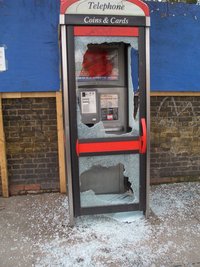Safety Glass
Toughened glass

Toughened glass (also tempered glass or safety glass) is made from annealed glass via a thermal tempering process. The glass is cut to the required size and any required processing (such as polishing the edges or drilling holes in the glass) is carried out before the toughening process starts.
The glass is placed onto a roller table, taking it through a furnace which heats it to above its annealing point of 600 °C. The glass is then rapidly cooled with forced draughts of air. This rapidly cools the glass surface below its annealing point, causing it to harden and contract, while the inner portion of the glass remains free to flow for a short time. The final contraction of the inner layer induces compressive stresses in the surface of the glass balanced by tensile stresses in the body of the glass. The pattern of cooling can be revealed by observing the glass with polarized light.
Toughened glass is typically assumed to be six times the strength of annealed glass. This is because any surface flaws tend to be pressed closed by the retained compressive forces, while the core layer remains relatively free of the defects which could cause a crack to begin.
However, this strength comes with a penalty. Due to the balanced stresses in the glass, any damage to the glass edges will result in the glass shattering into thumbnail sized pieces. This is why the glass must be cut to size before toughening and cannot be re-worked once toughened. Also, ironically, the toughened glass surface is not as hard as annealed glass and is more susceptible to scratching.
Toughened glass is typically used in unframed assemblies such as frameless doors and in structurally loaded applications.
Toughened glass is considered a safety glass due to its increased strength and its tendency to shatter in small, rounded pieces which are less likely to cause injury.
Using toughened glass could pose a security risk in some situations due to the tendency the glass has to shatter utterly upon edge impact.
Though the underlying mechanism was not known at the time, the effects of "tempering" glass have been known for centuries. In the 1640s, Prince Rupert of Bavaria (1619–1682), who was grandson of James I of England, and nephew of Charles I, brought the discovery of what are now known as "Prince Rupert's Drops" to the attention of the King. These are remarkable teardrop shaped bits of glass which are produced by allowing a molten drop of glass to fall into a bucket of water, thereby rapidly cooling it. The very rapid cooling produces tremendously high tensile stress in the glass giving it unusual qualities such as the ability to withstand a blow from a hammer on the bulbous end without breaking. However, even the smallest scratch on the "tail" of the drop will allow the large amount of potential energy contained in the internal stresses of the glass to be released, causing it to explosively shatter so thoroughly that it is converted to a fine powder. The drops were often used as a practical joke, as the King would tell a subject to hold the bulb end in the palm of their hand while he broke the tip, producing a small explosion in the surprised person's hand. A video of the technique can be seen here [1].
